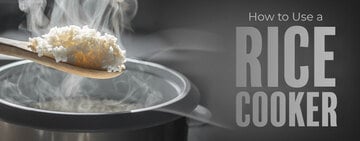Types of Sushi
If the perfect food existed, sushi would be a strong contender. It’s healthy, it’s convenient, and there are unlimited flavor combinations to try. Sushi is also just as pleasing to look at as it is to eat. It’s no wonder sushi is one of the most popular international dishes in the world. If you’re interested in opening your own sushi restaurant or adding sushi to your current menu, keep reading to learn all about the different kinds of sushi.
Shop All Sushi IngredientsWhat Is Sushi?
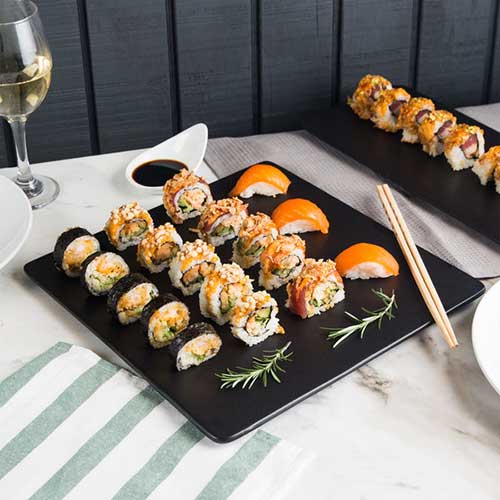
Sushi is a Japanese dish that features medium-grained rice cooked in vinegar, served with raw or cooked seafood and a variety of toppings or fillings. Contrary to popular belief, rice is the main component of sushi, not raw fish. You are probably familiar with the sight of rolled sushi sliced into perfect bite-sized pieces, but not all sushi is rolled.
What Is Sushi Vinegar?
To be considered sushi, the rice must be prepared with a certain type of vinegar. Sushi vinegar is made of rice vinegar, salt, and sugar. This gives the rice its signature flavor and a sticky texture that holds its shape when molded.
Zushi vs Sushi
On some sushi menus, you may see an alternate spelling for sushi that starts with a “z.” In the Japanese language, sushi becomes zushi when referring to specific types of sushi. For example, maki-sushi becomes maki-zushi. There is no difference between sushi and zushi other than pronunciation.
Different Types of Sushi
One of the great things about sushi is that there is a type for everyone. You don't even have to like raw fish to enjoy the perfect simplicity of an avocado roll. Keep reading to learn all about the different types of sushi and the common ingredients.
1. Sashimi
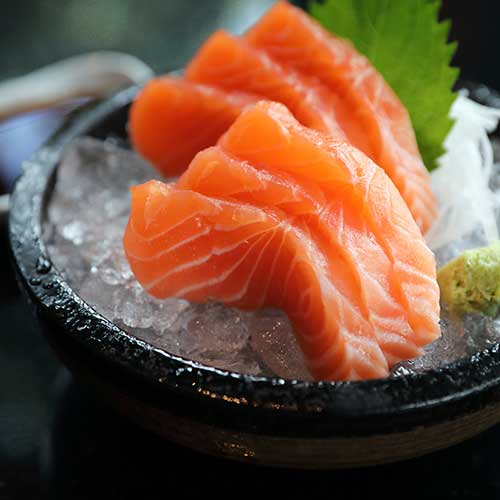
Technically, sashimi isn’t a type of sushi because it contains no rice. We're including it in our sushi guide because it plays an important role in Japanese cuisine. Sashimi is thinly sliced fish or meat, often served raw. It can be any type of meat, but fish and seafood are the most common types of sashimi.
Sashimi can also be cooked, like in the case of unagi (grilled eel). It’s common to serve slices of sashimi on a bed of daikon radish with a side of Asian sauces like ponzu, soy sauce, or a soy sauce substitute. No other toppings or fillings are added because sashimi is meant to highlight the fresh flavors of the fish.
For any seafood that is served raw, it's important to source your fish from trusted suppliers. Learn more in our sushi-grade fish guide.
Sashimi vs Sushi
Sushi always contains rice, while sashimi is just slices of meat or fish. Sashimi could be considered “no-rice sushi.”
Different Sashimi Types
- Sake - Raw salmon
- Ebi - Cooked shrimp
- Ahi - Raw tuna
- Unagi - Cooked freshwater eel
- Hamachi - Raw yellowtail
- Uni - Raw sea urchin
- Tako - Raw or poached octopus
2. Nigiri Sushi (Nigirizushi)
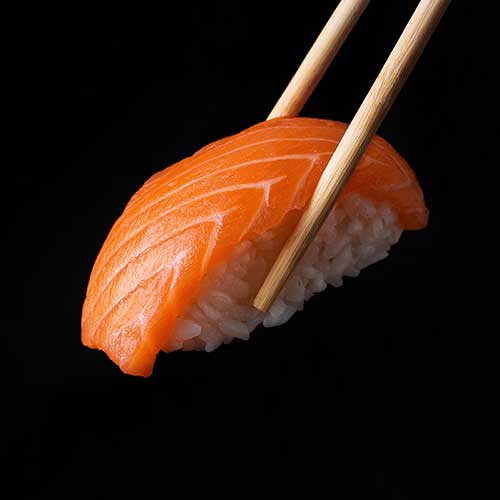
Nigiri is a type of sushi that combines a pillow of vinegared rice with a topping of raw or cooked seafood. These two ingredients are all that’s needed to create a perfect match of flavors and textures. Nigiri sushi is considered a simplistic delicacy in Japan, a contrast to the complicated sushi rolls that are enjoyed here in the West.
Nigiri vs Sushi
The difference between nigiri and sushi (maki) is that the rice in nigiri is pressed into a bite-sized mound, while maki sushi is rolled into a tube and sliced into rolls. Nigiri contains one piece of fish delicately placed on top, and maki rolls contain fillings on the inside.
Types of Nigiri
- Ebi Nigiri - Cooked butterflied shrimp
- Tamago Nigiri - Cooked egg omelet
- Unagi Nigiri - Grilled freshwater eel
- Sake Nigiri - Raw salmon
- Hotate Nigiri - Fresh raw scallop
- Maguro Nigiri - Raw tuna
3. Maki (Makizushi)
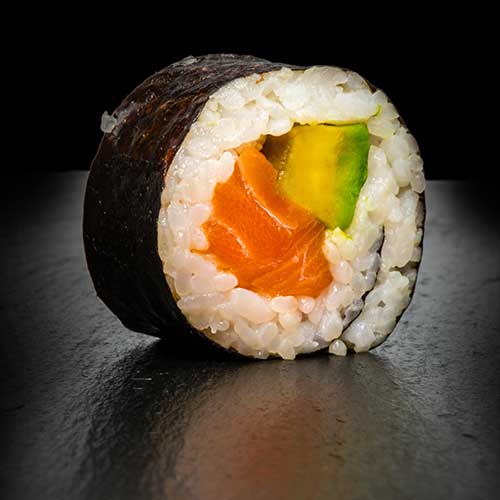
Maki sushi is made by layering a sheet of seaweed with vinegared rice and fillings. It’s firmly rolled into thin tubes and sliced into bite-sized pieces. When you look at a slice of maki sushi, you’ll see fillings on the inside, a coating of sticky rice, and a covering of thin seaweed paper (nori).
Maki Sushi Meaning
In Japanese, maki means “to roll.” All sushi rolls that are wrapped in seaweed with fillings on the inside are considered maki sushi.
Maki Roll vs Hand Roll
The difference between a maki roll and a hand roll (temaki) is that maki sushi is firmly rolled and sliced into several bite-sized pieces. A hand roll is loosely rolled into a tube or cone shape and meant to be eaten whole as an individual serving.
Types of Maki Rolls
- Hosomaki - Any small maki roll with only one filling is considered hosomaki sushi.
- Kappa Maki - This popular maki roll is made with seaweed, rice, and a cucumber filling.
- Tekka Maki - There are just three ingredients in tekka maki — seaweed, rice, and raw tuna.
- Futomaki - Futomaki means "fat roll" and this maki contains several fillings.
4. Uramaki (Uramakizushi)
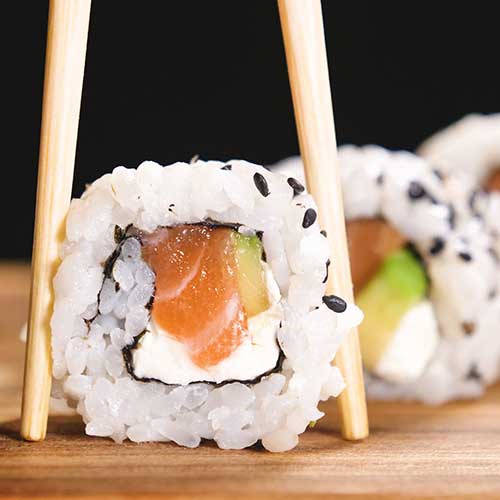
Uramaki sushi is rolled sushi with rice on the outside and nori on the inside. This “inside-out” roll was created in Los Angeles by a sushi chef who wanted to appeal to American customers. Machita Ichiro noticed that Americans weren’t fond of the seaweed wrapping on traditional maki sushi, so he hid the seaweed on the inside.
Traditional maki is still preferred in Japan, and uramaki is the most popular type of sushi in the US. Many of the sushi rolls referred to as “Special Rolls” on a sushi menu are types of uramaki. It's common for uramaki to be sprinkled with sesame seeds that cling to the sticky rice.
Different Sushi Rolls
- California Roll - This popular roll contains a filling of crabmeat or imitation crab, avocado, and cucumber.
- Rainbow Roll - The rainbow roll is similar to a California roll, but with a topping of colorful slices of raw fish like tuna, salmon, and yellowtail.
- Dragon Roll - A dragon roll contains a filling of cucumber, grilled eel, and shrimp tempura with a topping of sliced avocado that resembles dragon scales.
- Spicy Tuna Roll - The spicy tuna in this roll is made by finely chopping raw tuna and mixing it with sriracha and sesame oil. It's finished off with a topping of spicy mayo.
5. Temaki (Temakizushi)
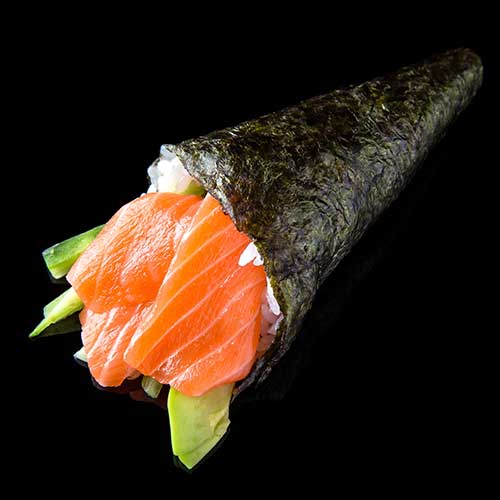
Temaki sushi is a little different from the other types of sushi on our list. A temaki hand roll consists of a large seaweed cone stuffed with rice, fish, and other sushi fillings. Unlike maki rolls, temaki isn’t rolled with the precise method that produces uniform pieces of sushi. A temaki hand roll is a little more deconstructed and is meant to be eaten by hand as an individual serving.
What Is a Sushi Burrito?
The sushi burrito, also called a sushirrito, is a fusion of temaki sushi with the overstuffed burritos that have become so popular in the last decade. While a temaki roll can be held in one hand, a sushi burrito is much larger. Instead of a flour tortilla, sushirittos are wrapped in a large nori sheet and feature typical sushi fillings like rice, fish, and vegetables.
6. Chirashi (Chirashizushi)
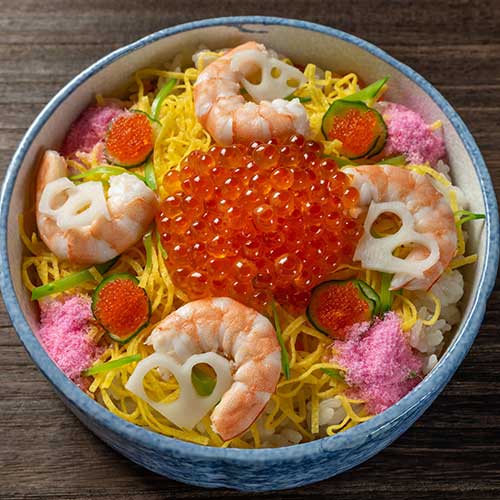
Chirashi is a lesser-known type of sushi that features a bed of sushi rice covered with toppings. The word chirashi means scattered, and it refers to the toppings placed on the sushi rice. But don't be confused by the term. Neatness and precision play a part in "scattering" the toppings over this sushi dish.
Types of Chirashi
There are several variations of chirashi sushi, but two of the most popular come from Tokyo and Osaka in Japan.
- Tokyo Style (Edomae Chirashi) - This style of chirashi sushi contains a topping of raw seafood like tuna, salmon, scallops, and squid.
- Osaka Style (Gomoku Chirashi) - Gomoku chirashi sushi is made with cooked ingredients and has a highly decorative appearance. It's common to see lotus root and fish roe as toppings.
Sushi Terms Glossary
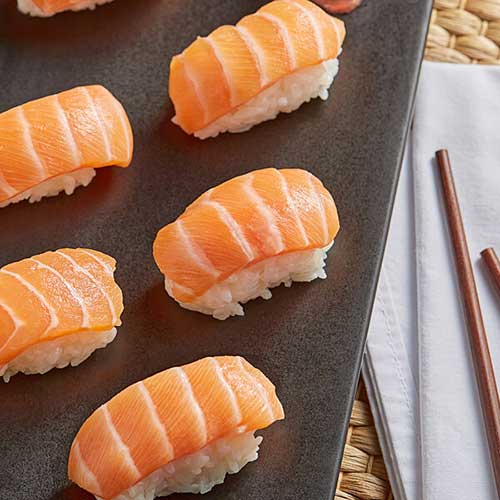
Because there are so many types of sushi ingredients and fillings, it can be difficult to remember all their names. Check out some common sushi terms and their meanings below:
- Ama Ebi - sweet shrimp, often served raw
- Awabi - abalone
- Daikon - white radish
- Gari - pickled ginger
- Gobo - burdock root
- Inari - deep-fried tofu pouch stuffed with sushi rice
- Kani-kama - imitation crab meat
- Masago - capelin fish roe (eggs)
- Nori - seaweed paper
- Natto - fermented soybeans
- Shoyu - soy sauce
- Tobiko - flying fish roe (eggs)
Sushi FAQs
We answer some common questions about sushi below:
Where Did Sushi Originate?
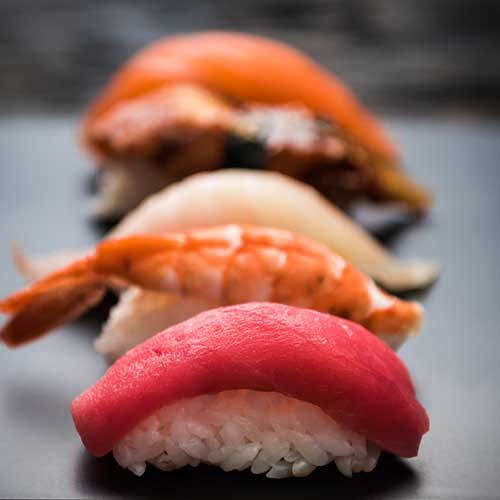
Sushi is a Japanese dish, but it's believed that its earliest form originated in China, where rice prepared with vinegar and salt was used as a method for preserving fish. The style and preparation of sushi that we know of today was a Japanese creation.
What Is Sushi Wrapped In?
Sushi rolls are wrapped in sheets of edible seaweed paper called nori.
What Does Sushi Mean?
In Japanese, sushi translates to "it is sour." This refers to the sushi rice cooked in vinegar.
What Does Tempura Mean?
Tempura is a cooking method in which vegetables or pieces of seafood are battered and deep-fried.
How Big Is a Sushi Roll?
The average sushi roll is about 7" to 8" in length and cut into 6 pieces. Thin rolls (hosomaki) that contain one ingredient are smaller than fat rolls (futomaki).
You can't go wrong by adding sushi to your menu! It's a dish that combines artful presentation with fresh ingredients. Each piece contains the perfect combo of flavors and textures, all wrapped up in one convenient bite-sized mouthful.



